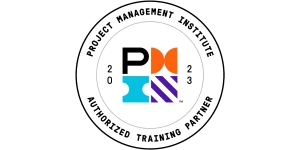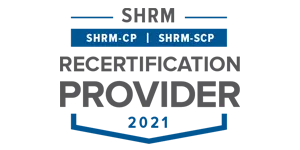Enterprise Agility: The Guide to Building a Responsive Organization
In a world where 52% of Fortune 500 companies from 2000 no longer exist today, adaptability isn’t just beneficial—it’s essential for survival.
Market disruptions, technological advances, and global crises have accelerated the need for organizations to respond swiftly to change. This is where enterprise agility comes into play.
Want to understand the fundamentals of process improvement?
Learn how to drive organizational transformation from the ground up with Lean Six Sigma Green Belt Certification.

Enterprise agility refers to an organization’s ability to quickly adapt, respond, and succeed in rapidly changing environments while maintaining stability in core operations.
Unlike traditional agile methodologies limited to IT departments, enterprise agility extends these principles across the entire organization, creating a cohesive ecosystem that thrives on change rather than resists it.
Organizations that master enterprise agility outperform their peers by 20 to 30% in revenue growth and 20% in profitability, according to recent McKinsey research.
Understanding the fundamentals of enterprise agility—and how it connects with methodologies like six sigma certification—is the first step toward building a truly responsive organization.
Key Highlights
- Faster market response capabilities
- Enhanced customer satisfaction metrics
- Improved cross-departmental operational efficiency
- Sustainable competitive market advantage
- Higher employee engagement levels
What is Enterprise Agility?
Enterprise agility represents an organization’s capacity to sense market changes and respond quickly while maintaining operational stability.
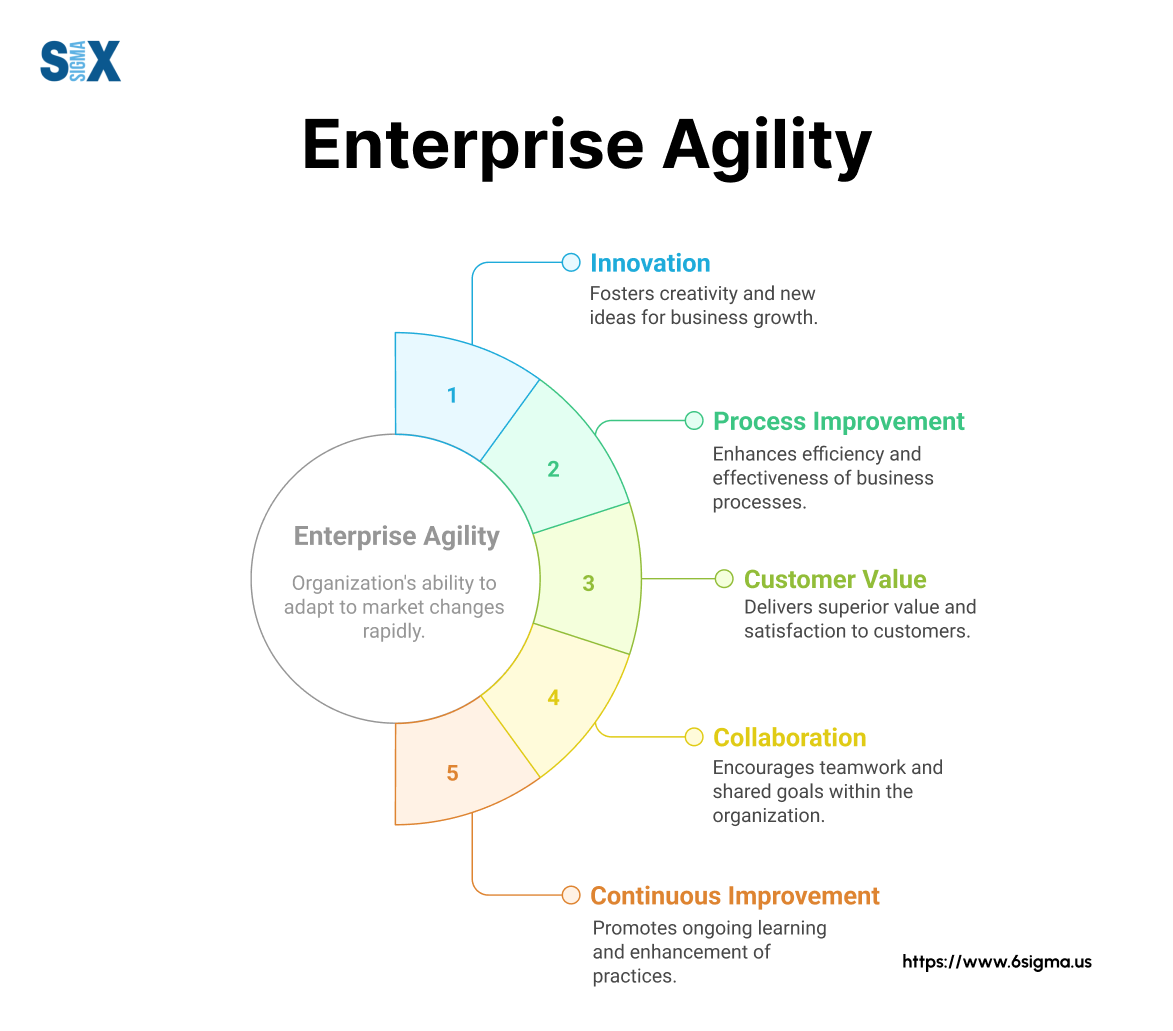
Unlike isolated agile practices, enterprise agility transforms the entire organizational structure, culture, and processes to create a unified system that anticipates and adapts to change.
The concept has evolved significantly over the past decade. Initially, agile methodologies focused primarily on software development teams, emphasizing iterative development and customer feedback.
Today’s enterprise agile approach extends these principles beyond IT departments to finance, marketing, HR, and operations—creating an interconnected ecosystem where information flows freely and decisions happen rapidly.
Many organizations find that enterprise agility works synergistically with Lean Six Sigma methodologies.
While Lean Six Sigma focuses on eliminating waste and reducing variation in processes, agility enterprise models prioritize adaptability and speed.
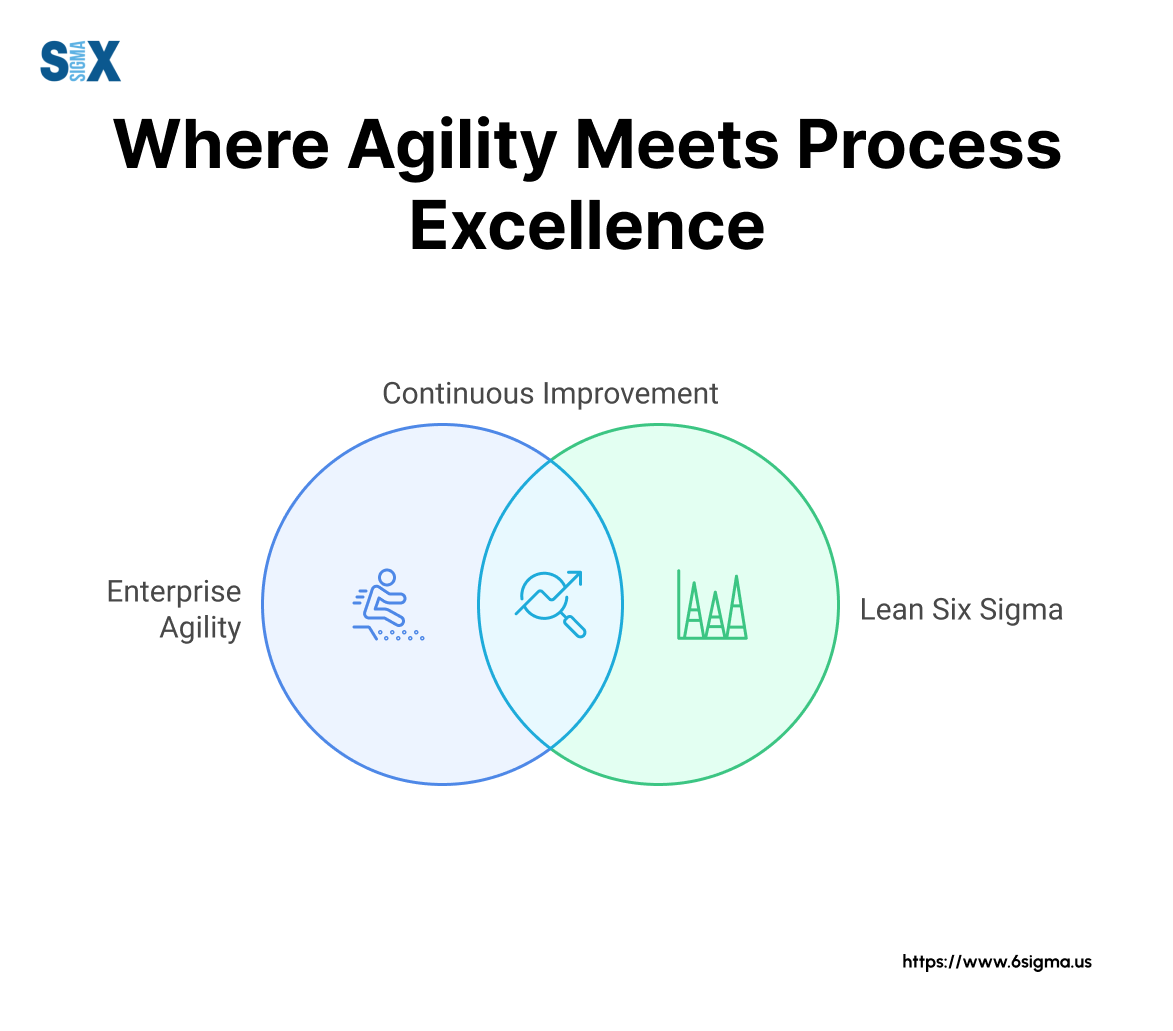
Enterprise Agility vs. Business Agility: Understanding the Distinction
Organizations often confuse enterprise agility with business agility, but these concepts serve different purposes in the organizational transformation journey:
| Aspect | Enterprise Agility | Business Agility |
|---|---|---|
| Scope | Entire organization including support functions | Primarily business operations and customer-facing units |
| Focus | Structural and systemic change | Operational responsiveness |
| Timeframe | Long-term transformation | Medium-term adaptation |
| Leadership Involvement | C-suite driven | Department-level implementation |
| Metrics | Organization-wide KPIs | Business unit performance indicators |
Enterprise business agility integrates principles from both approaches, creating a holistic model where all organizational elements work together toward common goals.
Many organizations implementing enterprise agility find value in incorporating six sigma certification principles, particularly when addressing process stability issues that might otherwise hinder agile transformation.
The most successful organizations don’t view these methodologies as competing approaches but rather as complementary tools in their organizational effectiveness toolkit.
The Strategic Framework of Enterprise Agility
Successful enterprise agility requires more than adopting a few agile practices—it demands a cohesive framework that touches every aspect of the organization.
The most effective agile enterprise frameworks balance three critical components that work together to create a responsive yet stable organization.
First, organizational structure must evolve from traditional hierarchies to networked teams. Companies like ING and Spotify have pioneered models where small, cross-functional teams operate with significant autonomy while maintaining alignment with strategic objectives.
These structures flatten decision-making processes, reducing the time between identifying market opportunities and taking action.
Second, process optimization serves as the engine of enterprise agility. Organizations must redesign workflows to eliminate bottlenecks and unnecessary handoffs.
This is where integration with fundamentals of Lean becomes particularly valuable. Lean principles help identify and eliminate waste in processes, creating the efficiency needed for true agility.
Companies that master this integration report 40% faster time-to-market for new offerings.
Third, technology enablement provides the infrastructure for agile operations. Modern enterprise agile frameworks leverage cloud platforms, API ecosystems, and automation to create technical environments that can quickly adapt to changing requirements.
Without this technological foundation, even the best organizational structures and processes will struggle to deliver true enterprise agility.
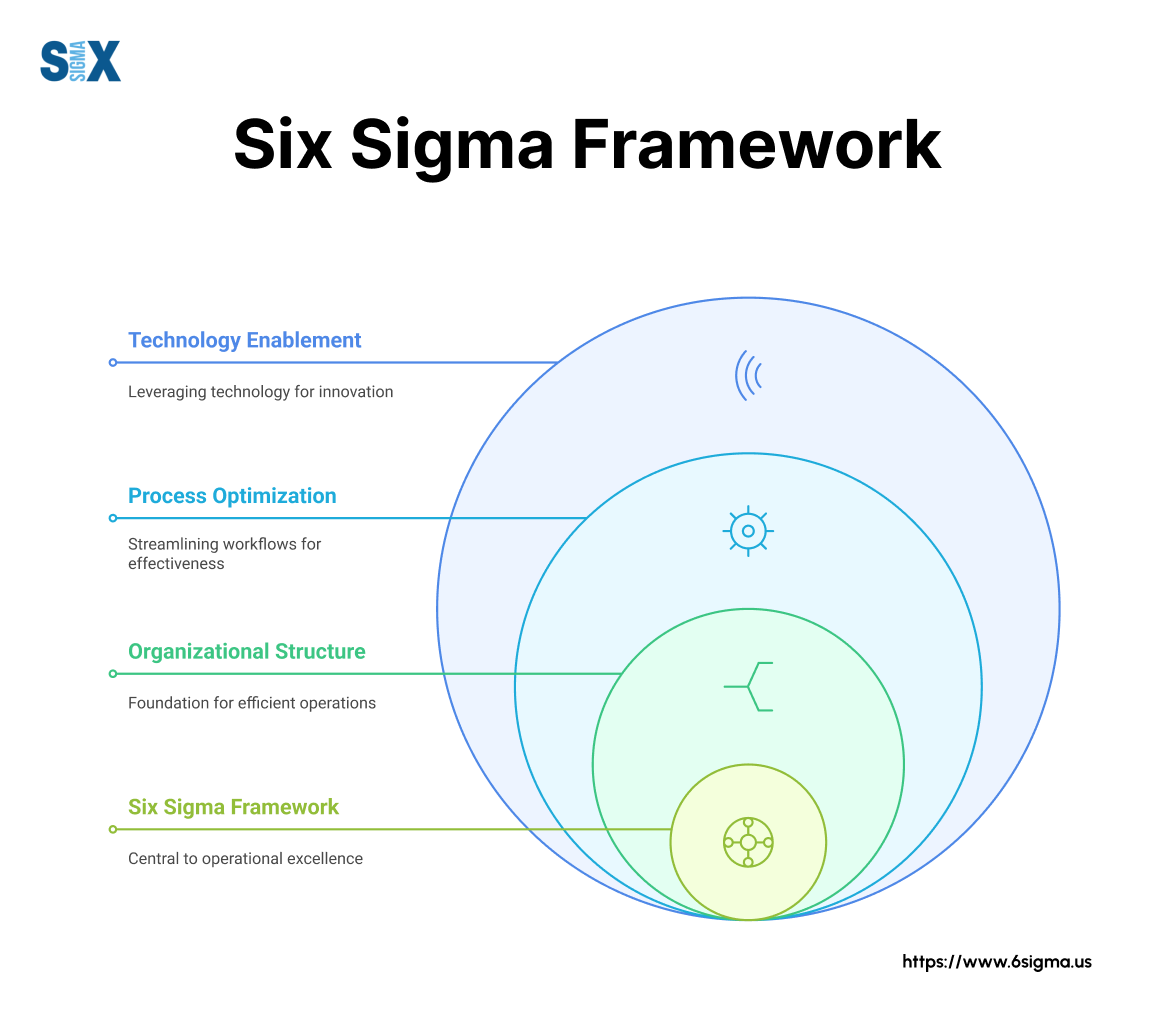
Popular Enterprise Agility Frameworks in Practice
Several enterprise agile frameworks have emerged to guide organizations through transformation, each with distinct approaches to scaling agility across the enterprise.
The Scaled Agile Framework (SAFe) stands as the most widely adopted enterprise agility framework, particularly in larger organizations. SAFe provides detailed guidance for implementing agile practices at team, program, and portfolio levels.
Its structured approach appeals to organizations transitioning from traditional project management, though critics note it can sometimes preserve hierarchical elements that limit true agility.
The scaled agile framework enterprise model works well for organizations that need significant structure during transformation.
Large-Scale Scrum (LeSS) takes a different approach, focusing on simplicity and staying true to core Scrum principles.
Rather than adding layers, LeSS scales by removing organizational complexity. This framework works particularly well for product-focused companies where multiple teams work on a single product.
Organizations implementing LeSS report higher team satisfaction but sometimes struggle with the significant organizational restructuring required.
Disciplined Agile (DA) offers a more flexible approach to enterprise agile frameworks. Rather than prescribing specific practices, DA provides a toolkit of techniques that organizations can select based on their context.
This framework particularly excels at integrating agile principles with existing governance structures, making it popular in regulated industries like finance and healthcare.
Each of these agile enterprise solutions can be enhanced by incorporating lean principles. Organizations that blend enterprise agility frameworks with the fundamentals of Lean create systems that not only respond quickly but do so efficiently—eliminating the waste that often accompanies rapid change.

Seeking advanced skills to optimize complex business processes?
Become the strategic leader who drives meaningful change with Six Sigma Black Belt Certification.
Implementing Enterprise Agility
Transforming an organization into an agile enterprise requires methodical planning, strategic execution, and cultural evolution—a journey that separates successful transformations from failed experiments.
Assessment and Planning: Building the Foundation
The journey toward enterprise agility begins long before implementing new frameworks or reorganizing teams.
Organizations that rush into transformation without proper assessment often find themselves dealing with resistance, misalignment, and ultimately, failed initiatives.
Effective enterprise agile planning starts with a thorough readiness evaluation.
This assessment examines current organizational capabilities across multiple dimensions, including leadership mindset, team structures, existing processes, and technological infrastructure.
Leading organizations use specialized enterprise agile planning tools to measure their baseline and identify specific improvement opportunities.
Strategy development follows assessment, creating a roadmap tailored to organizational realities.
This strategy must balance ambition with pragmatism, addressing both quick wins and longer-term structural changes.
The most effective strategies incorporate root cause analysis techniques to ensure transformation efforts address underlying issues rather than symptoms.
For example, if assessment reveals slow decision-making as a barrier to enterprise agility, root cause analysis might identify approval hierarchies, risk aversion, or information silos as the true obstacles. Addressing these root causes creates lasting improvement rather than temporary fixes.
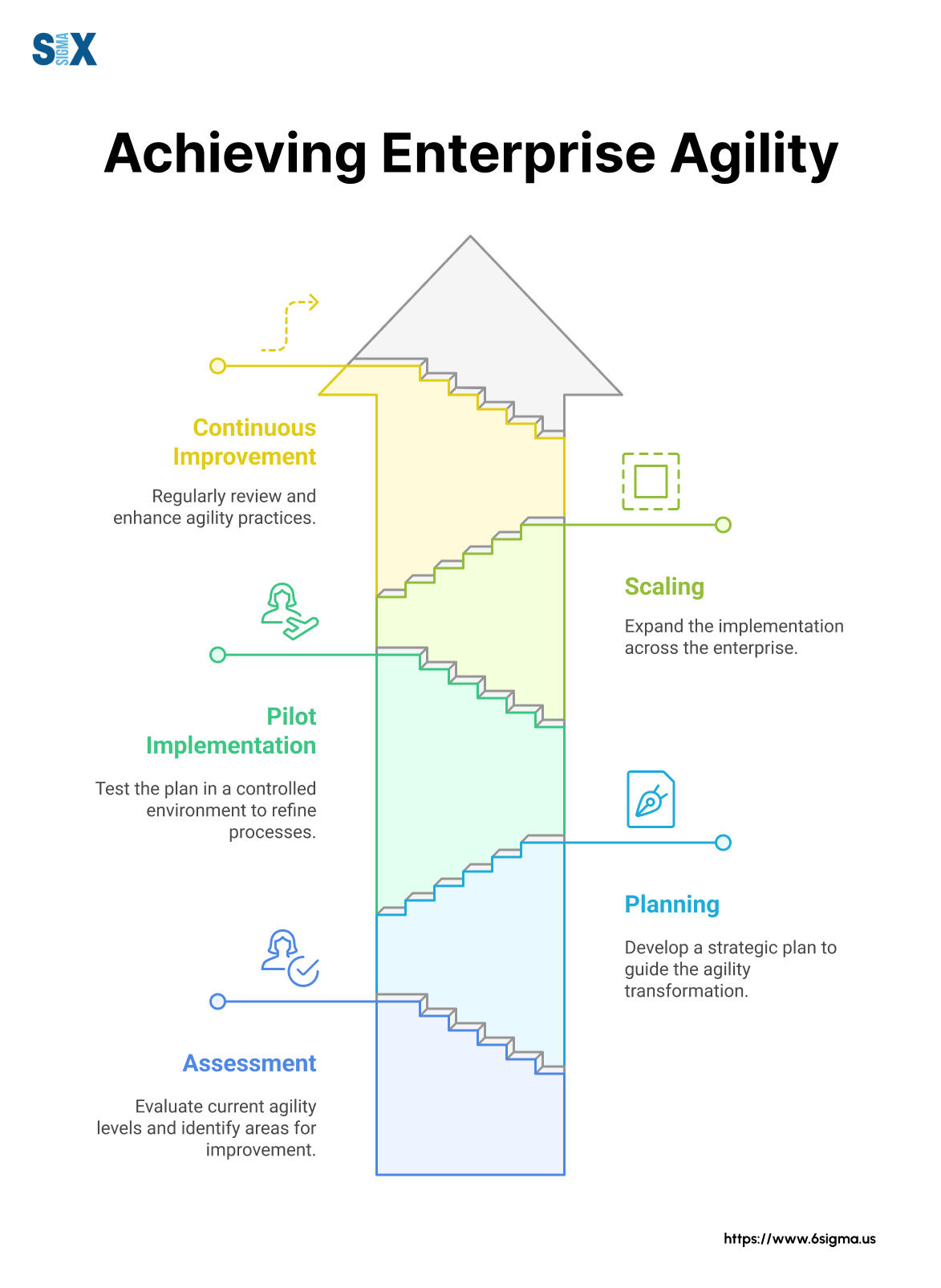
Transformation Process: From Vision to Reality
With assessment complete and strategy defined, organizations can begin the actual transformation process. Successful enterprise agile transformation typically follows a structured approach:
- Start with leadership alignment. Executives must understand and embody agile principles before the organization can truly transform. This often requires dedicated education and coaching for senior leaders.
- Establish a transformation team with representation from across the organization. This cross-functional group drives implementation and addresses barriers as they arise.
- Begin with pilot initiatives in receptive areas of the business. These controlled experiments build momentum and provide learning opportunities before wider rollout.
- Scale successful practices gradually, adapting them to different business contexts. The most effective agile enterprise transformation efforts recognize that different parts of the organization may require different approaches.
- Continuously measure progress against defined metrics, adjusting course as needed.
Throughout this process, change management proves critical to success. Organizations must address the human side of transformation through clear communication, involvement strategies, and recognition programs that reinforce desired behaviors.
Many organizations find value in leveraging professionals with a six sigma black belt certification training during enterprise agility implementation.
These experts bring structured problem-solving approaches and data analysis skills that complement agile practices. Their expertise proves particularly valuable when optimizing processes as part of the transformation.
The most successful enterprise agile transformations balance structure and flexibility. While following a defined roadmap, they remain open to learning and adaptation as the organization evolves.
This paradox—planned adaptability—exemplifies the essence of enterprise agility itself.
Enterprise Agility in Practice
Theory meets reality when organizations implement enterprise agility principles in their unique business environments—revealing both transformative potential and practical challenges.
Real-World Success Stories and Challenges
Financial giant ING’s transformation stands as a landmark case study in enterprise agility. The bank reorganized its 3,500 staff into autonomous, customer-focused squads, eliminating traditional department structures.
This agile enterprise architecture resulted in a 30% reduction in time-to-market for new products and a 20-point improvement in Net Promoter Score within 18 months.
Philips Healthcare faced different challenges when implementing enterprise agility across its medical device division. Regulatory requirements initially seemed incompatible with agile approaches.
The solution came through creating specialized compliance teams that worked alongside product squads, maintaining documentation while preserving agility. This hybrid approach maintained regulatory adherence while reducing development cycles by 40%.
In both cases, certified professionals played crucial roles. Agile coaches guided leadership teams, while Six Sigma experts helped optimize underlying processes.
Industry-Specific Applications of Enterprise Agility
Manufacturing organizations implement enterprise agility with particular focus on supply chain responsiveness.
Companies like Toyota have evolved their lean manufacturing systems to incorporate agile principles, creating hybrid models that maintain efficiency while improving adaptability to market changes.
Service industries emphasize customer experience in their enterprise agility implementations. Insurance provider USAA reorganized around customer journeys rather than functional departments, breaking down silos between claims, underwriting, and customer service.
Technology companies typically lead in enterprise agility adoption, but face unique challenges in scaling.
Spotify’s famous “squad model” works well for its digital products but required significant adaptation when applied to hardware development at companies like Microsoft.
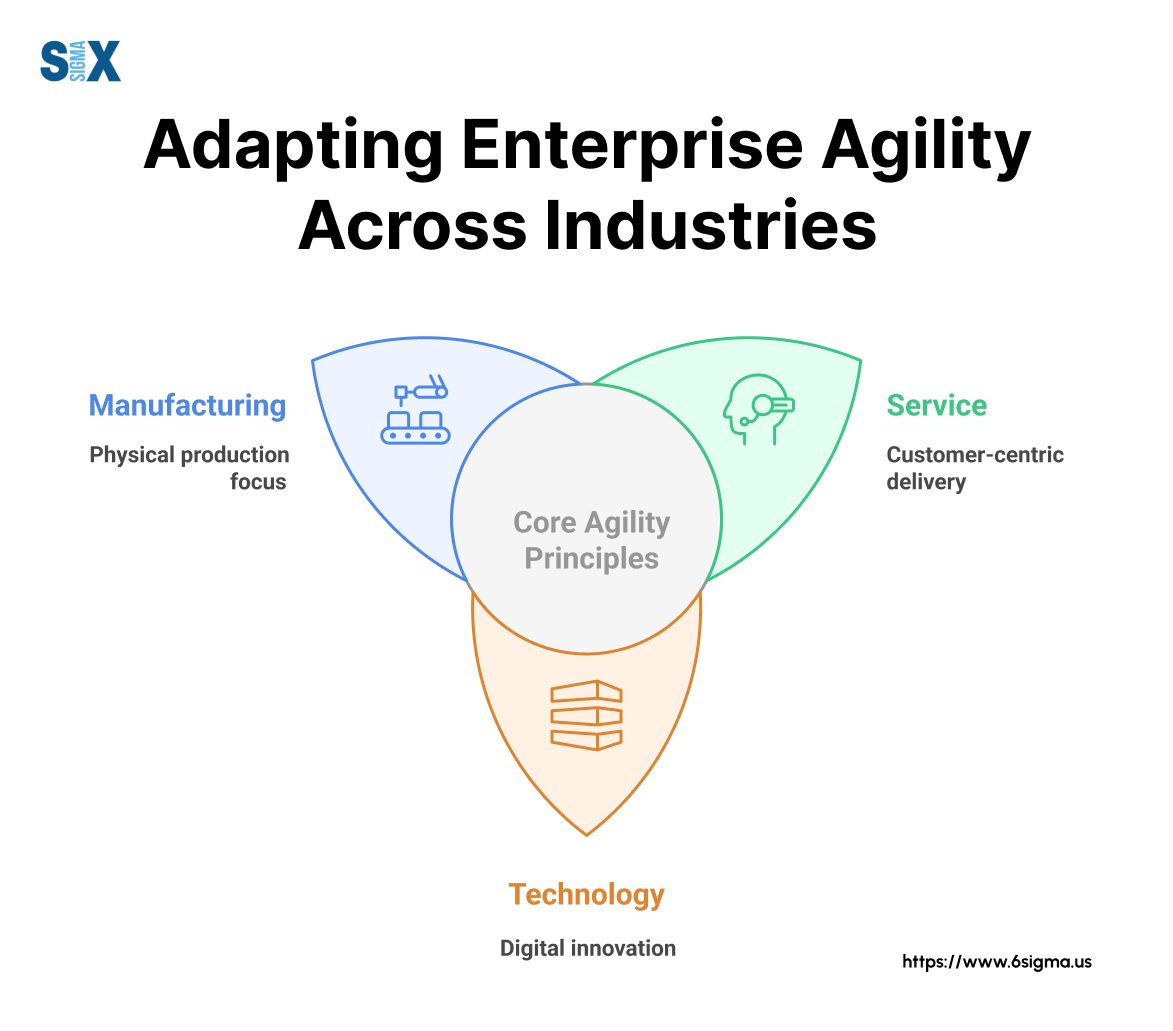
Regardless of industry, successful enterprise agility implementations share common elements: strong executive sponsorship, cultural transformation emphasis, and willingness to adapt frameworks to organizational realities rather than forcing rigid compliance.
Future of Enterprise Agility
As markets continue to evolve at accelerating rates, enterprise agility itself must transform to meet emerging challenges and leverage new technologies.
Emerging Trends Reshaping Enterprise Agility
Artificial intelligence and machine learning are revolutionizing how organizations implement enterprise agility.
Predictive analytics now enable companies to anticipate market shifts rather than merely respond to them.
JP Morgan Chase deployed AI systems that analyze customer behavior patterns and market indicators, allowing business units to proactively adjust strategies before competitors even recognize changing conditions.
Digital transformation continues to blur industry boundaries, requiring new dimensions of enterprise agility definition and practice.
This expanded enterprise agility definition encompasses not just market and technological change but environmental and social dynamics as well.
Integration with Complementary Methodologies
DevOps practices increasingly merge with enterprise agility to create seamless connections between business strategy and technical delivery.
While enterprise agility provides the organizational framework for responsiveness, DevOps delivers the technical capabilities needed for rapid, reliable deployment.
Organizations that master this integration achieve remarkable speed-to-market advantages, with companies like Amazon deploying code changes thousands of times daily.
Design thinking methodologies complement enterprise agility by strengthening customer-centricity and innovation capabilities.
Organizations like IBM have integrated design thinking practices into their agile frameworks, ensuring that increased speed doesn’t come at the expense of customer value. This combination proves particularly powerful when entering new markets or creating disruptive offerings.
Six Sigma continues to play a valuable role in mature enterprise agility implementations.
Professionals with a six sigma master black belt certification bring statistical rigor and process excellence to agile environments, ensuring that speed doesn’t compromise quality.
Conclusion
Enterprise agility has evolved from a niche methodology to a strategic imperative for organizations facing unprecedented market volatility.
By enabling rapid adaptation while maintaining operational stability, enterprise agility delivers competitive advantages that traditional organizational models simply cannot match.
The journey toward enterprise agility requires thoughtful assessment, strategic planning, and cultural transformation—but organizations that successfully navigate this path reap substantial rewards.
For executives considering this journey, the first step involves honest evaluation of current capabilities and limitations.
Middle managers should prepare for changing roles that emphasize coaching and enablement rather than control.
Individual contributors across functions should expect increased autonomy and cross-functional collaboration.
The future belongs to organizations that can sense and respond to change with speed and precision—enterprise agility provides the foundation for building exactly that capability.
SixSigma.us offers both Live Virtual classes as well as Online Self-Paced training. Most option includes access to the same great Master Black Belt instructors that teach our World Class in-person sessions. Sign-up today!
Virtual Classroom Training Programs Self-Paced Online Training Programs

